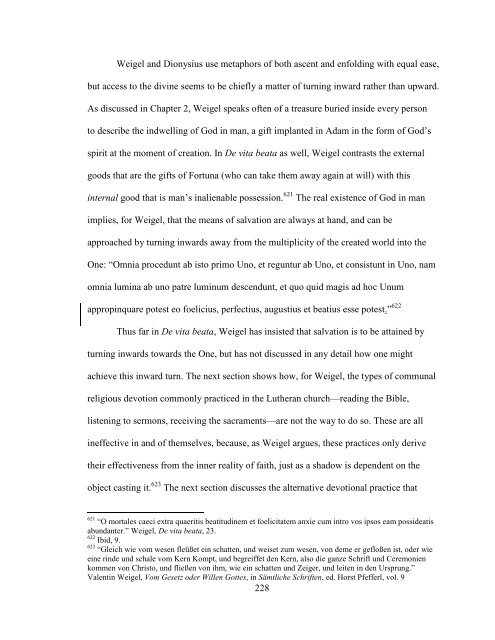the mystical theology of valentin weigel - DataSpace at Princeton ...
the mystical theology of valentin weigel - DataSpace at Princeton ...
the mystical theology of valentin weigel - DataSpace at Princeton ...
Create successful ePaper yourself
Turn your PDF publications into a flip-book with our unique Google optimized e-Paper software.
Weigel and Dionysius use metaphors <strong>of</strong> both ascent and enfolding with equal ease,<br />
but access to <strong>the</strong> divine seems to be chiefly a m<strong>at</strong>ter <strong>of</strong> turning inward ra<strong>the</strong>r than upward.<br />
As discussed in Chapter 2, Weigel speaks <strong>of</strong>ten <strong>of</strong> a treasure buried inside every person<br />
to describe <strong>the</strong> indwelling <strong>of</strong> God in man, a gift implanted in Adam in <strong>the</strong> form <strong>of</strong> God’s<br />
spirit <strong>at</strong> <strong>the</strong> moment <strong>of</strong> cre<strong>at</strong>ion. In De vita be<strong>at</strong>a as well, Weigel contrasts <strong>the</strong> external<br />
goods th<strong>at</strong> are <strong>the</strong> gifts <strong>of</strong> Fortuna (who can take <strong>the</strong>m away again <strong>at</strong> will) with this<br />
internal good th<strong>at</strong> is man’s inalienable possession. 621 The real existence <strong>of</strong> God in man<br />
implies, for Weigel, th<strong>at</strong> <strong>the</strong> means <strong>of</strong> salv<strong>at</strong>ion are always <strong>at</strong> hand, and can be<br />
approached by turning inwards away from <strong>the</strong> multiplicity <strong>of</strong> <strong>the</strong> cre<strong>at</strong>ed world into <strong>the</strong><br />
One: “Omnia procedunt ab isto primo Uno, et reguntur ab Uno, et consistunt in Uno, nam<br />
omnia lumina ab uno p<strong>at</strong>re luminum descendunt, et quo quid magis ad hoc Unum<br />
appropinquare potest eo foelicius, perfectius, augustius et be<strong>at</strong>ius esse potest.” 622<br />
Thus far in De vita be<strong>at</strong>a, Weigel has insisted th<strong>at</strong> salv<strong>at</strong>ion is to be <strong>at</strong>tained by<br />
turning inwards towards <strong>the</strong> One, but has not discussed in any detail how one might<br />
achieve this inward turn. The next section shows how, for Weigel, <strong>the</strong> types <strong>of</strong> communal<br />
religious devotion commonly practiced in <strong>the</strong> Lu<strong>the</strong>ran church—reading <strong>the</strong> Bible,<br />
listening to sermons, receiving <strong>the</strong> sacraments—are not <strong>the</strong> way to do so. These are all<br />
ineffective in and <strong>of</strong> <strong>the</strong>mselves, because, as Weigel argues, <strong>the</strong>se practices only derive<br />
<strong>the</strong>ir effectiveness from <strong>the</strong> inner reality <strong>of</strong> faith, just as a shadow is dependent on <strong>the</strong><br />
object casting it. 623 The next section discusses <strong>the</strong> altern<strong>at</strong>ive devotional practice th<strong>at</strong><br />
621 “O mortales caeci extra quaeritis be<strong>at</strong>itudinem et foelicit<strong>at</strong>em anxie cum intro vos ipsos eam posside<strong>at</strong>is<br />
abundanter.” Weigel, De vita be<strong>at</strong>a, 23.<br />
622 Ibid, 9.<br />
623 “Gleich wie vom wesen fleüßet ein sch<strong>at</strong>ten, und weiset zum wesen, von deme er gefloßen ist, oder wie<br />
eine rinde und schale vom Kern Kompt, und begreiffet den Kern, also die ganze Schrift und Ceremonien<br />
kommen von Christo, und fließen von ihm, wie ein sch<strong>at</strong>ten und Zeiger, und leiten in den Ursprung.”<br />
Valentin Weigel, Vom Gesetz oder Willen Gottes, in Sämtliche Schriften, ed. Horst Pfefferl, vol. 9<br />
228
















